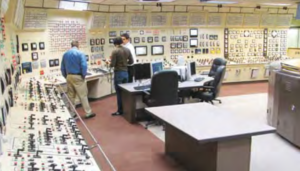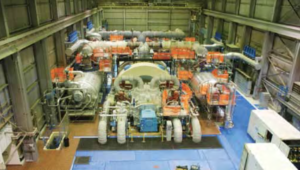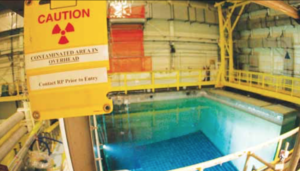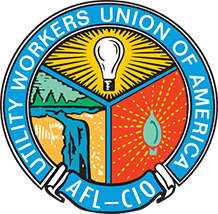National Union Unites Locals in Fight for Nuclear Decommissioning Work
The U.S. nuclear powerplant fleet has been providing reliable, carbon-free electricity for the country since an early reactor, located at Fort Belvoir, Virginia first began feeding power onto the commercial grid in 1957. Over the following decades, more than 100 were built, primarily in eastern and southern states, and around two dozen west of the Mississippi River. The annual electric output from this fleet is enormous, measured in terawatt-hours per year, and currently accounting for as much as 20% of total American electric generation, all without emissions contributing to climate change.
 Over time, a number of reactors closed for various reasons but, recently, the pace of nuclear plant closures has begun to increase as economic pressures from competing sources of electric generation, and the costs associated with continuing to maintain the fleet, particularly in deregulated electric markets, have led some companies to exit the nuclear power generation business. In all, the industry trade association, the Nuclear Energy Institute (NEI), cites 30 reactors that have been taken out of service and are currently in various stages of being dismantled, with several more poised on the horizon.
Over time, a number of reactors closed for various reasons but, recently, the pace of nuclear plant closures has begun to increase as economic pressures from competing sources of electric generation, and the costs associated with continuing to maintain the fleet, particularly in deregulated electric markets, have led some companies to exit the nuclear power generation business. In all, the industry trade association, the Nuclear Energy Institute (NEI), cites 30 reactors that have been taken out of service and are currently in various stages of being dismantled, with several more poised on the horizon.
Among those now marked for closure are three operated by UWUA members: the Indian Point Energy Center located in Buchanan, New York; the Palisades Nuclear Generating Station near Charlevoix, Michigan; and the Pilgrim Nuclear Power Station in Plymouth, Massachusetts. All three are owned and operated by Entergy, a power company headquartered in New Orleans, Louisiana. Those three facilities, along with a fourth, Vermont Yankee Nuclear Power Station in Vernon, Vermont, formed Entergy’s nuclear fleet in the northern United States.

Big Rock Point and San Onofre – the UWUA experience
As the closing and demolition of a nuclear powerplant is uniquely specialized, requiring highly skilled labor, the entire process can take many years, even when done as expeditiously as possible. Historically, UWUA members have had experience performing this work in two instances. The first, at the Big Rock Point Nuclear Plant near Charlevoix, Michigan involved physically dismantling the plant over the course of eight years beginning in 1997 when the plant was taken offline after 35 years of operation. Today, a concrete pad holding dry casks of spent nuclear fuel is all that remains.
The work of bringing the plant to that point was performed by UWUA members, many of whom were the same workers who had performed operations and maintenance work at the plant while it was running. Having these workers remain on site and perform the task of decommissioning ensured that the people most familiar with the safe operation of the plant, people who had often spent decades working on Big Rock Point’s equipment, were able to take the plant down in the safest manner possible, all while ensuring several years of work and income for the local workforce. Having this long winding down process gave people, and the nearby community, time to adjust, make plans, and chart out the next stage of life after the plant was gone.

By contrast, in 2013 the announced closure of the San Onofre Nuclear Generating Station near San Diego, California came with a plan by the employer, Southern California Edison, to immediately begin outsourcing the work of closing and fully decommissioning the plant. In the span of about two years, a bargaining unit that had once represented as many as 800 Local 246 members steadily tapered off to about two dozen people as one department after another was turned over to third party contractors.
Now poised to begin the multi-year task of physically dismantling the San Onofre plant, the company has arranged for the work to be done almost entirely by outside contractors. Through a combination of severance bargaining, and maintaining relationships with nuclear workforces elsewhere around the country, Local 246 was able to assist a portion of its membership in securing benefits and finding new placements at other reactors but, for many of them, this has necessarily involved leaving their communities behind. Further, as the total number of reactors in the nuclear fleet continues to decline, this strategy of placement elsewhere will become ever more difficult as the years go by, making it more important than ever that workers at closing nuclear plants have the opportunity to taper off their work over years of decommissioning, rather than being suddenly shown the door.
Vermont Yankee – a template for future closures?
With the Entergy closures slated to occur in 2022 (Palisades), 2019 (Pilgrim), and 2021 (Indian Point) the UWUA’s National leadership set up a decommissioning task force, that includes Local 1-2 in New York, Local 369 in Massachusetts, and the Michigan State Utility Workers Council, to aggressively move forward on multiple fronts to understand how Entergy intends to go about the process of closing and dismantling these facilities and who will be a part of the workforce that performs this decommissioning work.

“Our members operated these plants since they came on line, they know them inside and out and can do the decommissioning work better than anyone,” said UWUA President Mike Langford when setting up the union’s decommissioning task force. “We know it pays to have the experienced, in-house workforce do the decommissioning work.”
With Local 1-2 poised to begin its regular contract negotiations at the beginning of 2018, UWUA’s National and local officers convened a single, united process to engage Entergy in a multi-local discussion focused solely on the subject of decommissioning work, post-shutdown, and to examine how the company has gone about closing its fourth reactor in the northeast, Vermont Yankee.
At Vermont Yankee, Entergy’s approach, as publicly proposed to the federal Nuclear Regulatory Commission and the Vermont Public Utility Commission, will be to transfer the plant to another company entirely, Northstar Group Services. Working in conjunction with companies from Texas and Missouri, as well as AREVA, a company owned by the French government, Northstar would set about the work of dismantling the plant with a combined workforce drawn from these companies. Taking this approach at Indian Point, Palisades, and Pilgrim could potentially result in the loss of years of work for UWUA members at each of those plants, an approach that the union seeks to resist through pro-active, immediate engagement with the company.
First steps already taken on the path forward
Having struck a tentative agreement on their underlying contract with Entergy for the workers at Indian Point, an agreement slated for a vote shortly, the union’s focus on separate decommissioning talks can now move forward. With the stakes high for so many UWUA members and the communities in which they live, the union has already secured an agreement to begin meeting with Entergy within the next two months.
Rather than attempting separate discussions in each state, however, these meetings will involve the leadership of the National and all three locals, to attempt to hammer out a unified approach to decommissioning at each facility. Further efforts are also underway to engage with community groups, elected officials, activists, and the media to ensure everyone with a stake in the future of these nuclear host communities is aware, empowered, and heard, as a part of the process.
With the proper vision, these plants still have the potential to provide high-quality jobs for many years to come before they are finally brought to the very end of their life cycle. Fighting to make sure this work stays within the UWUA family will be the work of its leaders, members, and allies in the months and years ahead, a fight for which the UWUA is well equipped and intends to carry forward with full force for the benefit of all its union brothers and sisters in the nuclear power industry.

Caption: With Entergy expected to close three nuclear plants, UWUA National leadership set up a task force to secure as much decommissioning work as possible for members. The task force includes, clockwise from left: Michigan State Utility Workers Council President Pat Dillon, National President Mike Langford, National Secretary-Treasurer Michael Coleman, National Executive Vice President Steven VanSlooten, MA Local 369 President Craig Pinkham, NY Local 1-2 President James Slevin, National Vice President John Duffy, Director of Governmental Affairs Lee Anderson, and General Counsel David Radtke.

